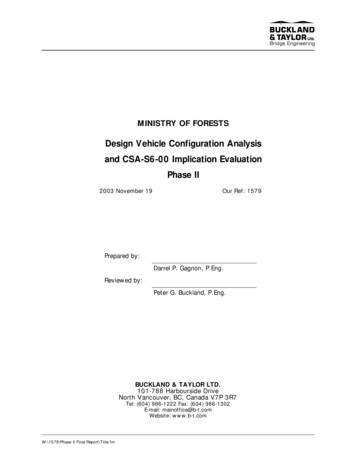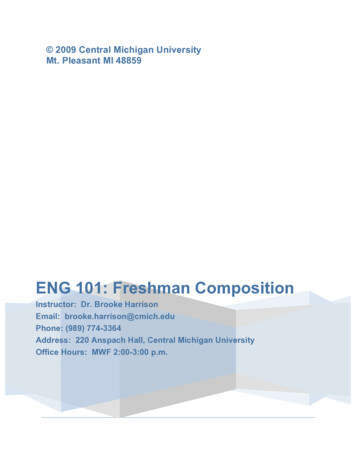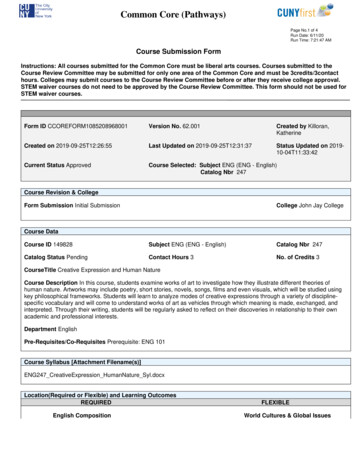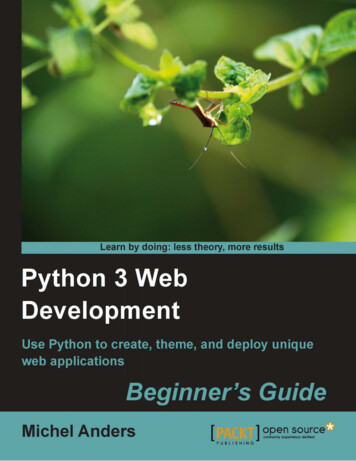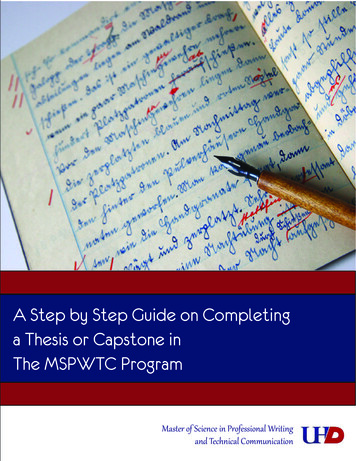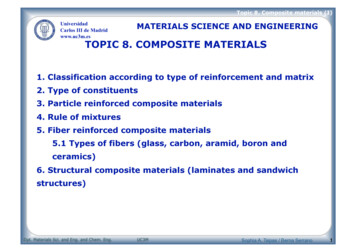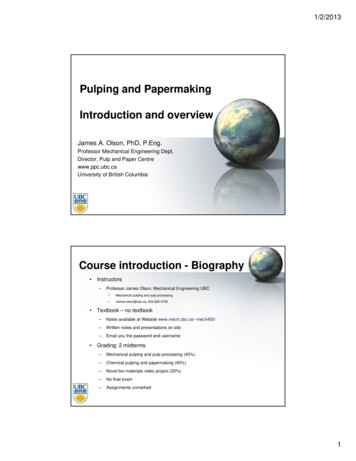
Transcription
TafsīrTal-JaalālayynBy:Jalāl al-Dīn al-MaḥallīJalāl al-Dīn al-SuyūṭīTRARANSLATEDD BYFerras HammzaEdited andd with an Intrroduction byd bin TalalGhazi binn MuhammadThe Ce TextComplete 2007 Rooyal Aal al-BBayt Institute for Islammic ThoughttAmmman, Jorddani
General Editor’s Introduction and ForewordIntroduction to Tafsīr al-JalālaynThe fifteenth-century Qur’anic commentary or Tafsīr of ‘the two Jalāls’ (al-Jalālayn) — the EgyptianShafi‘i-madhhab scholar Jalāl al-Dīn Muḥammad b. Aḥmad al-Maḥallī (d. 864 AH / 1459 CE), and his (alsoEgyptian) student the famous ‘ālim and polymath, Jalāl al-Dīn 'Abd al-Raḥmān b. Abī Bakr al-Suyūṭī (d. 911AH / 1505 CE) — is one of the most popular Tafsīrs in the Islamic world, perhaps even the most popularTafsīr. Copies of it are available in almost every bookshop and library in the Arab and Islamic world, indozens of different editions, and it sits, well-loved and respected, in countless homes, schools and mosquesall over the world. Moreover, of the great Sunni Orthodox Classical Tafsīrs — what might be called the‘unofficial Sunni Canon’ of Tafsīr — namely, the Tafsīrs of Ṭabarī, Rāzī, Qurṭubī, Bayḍāwī, Ibn Kathīr andJalālayn, it is by far the shortest and easiest to read and understand. Consequently, it is invariably read asan introduction to Classical Tafsīrs — or even to Tafsīr as such — such that for millions of students andadults who never go further into the subject, it is the only Tafsīr they ever come to know extensively. Finally,because it is so accessible and ubiquitous, and because in Arabic it is always printed in a single volume, inthe margins of the Qur’an itself (where it fits quite easily and legibly), it is habitually used as an instantreference work for words in the Qur’an whose meaning is not immediately clear to the modern reader, andthis arguably is its real forte. It is thus an immensely successful and influential work not just as the classicintroduction to Tafsīr, but also as the standard reference work for the language of the Qur’an.The Method and Strategy of Tafsīr al-JalālaynThe Tafsīr al-Jalālayn is usually categorized as a Tafsīr bil-Ma'thūr — that is, a ‘commentary basedupon transmitted knowledge’ (from the Ḥadīth, the first Tafsīrs and the early Islamic history books, usually)— this being the primary category of perhaps six or seven traditional categories of Tafsīr.[1] This, however, isdeceptive. In fact, in addition to the material handed down from the time of the Prophet Muhammad(p.b.u.h.), the Tafsīr al-Jalālayn uses a number of different approaches to explaining the Qur’anic text, notall of which can be attributed only to transmitted Tradition or tafsīr bil-ma'thūr. These include precisely‘linguistic commentary’, ‘legal or Shari‘ah commentary’ and tafsīr bil-tafsīr as mentioned below (as differentcategories of commentaries). They also include, however, a few other elements, perhaps no less important.Thus, in addition to: (1) giving transmitted explanations and quoting ḥadīths about Qur’anic verses, (2)providing Arabic synonyms for difficult Qur’anic words, (3) elaborating on legal explanations of versesaccording (mostly) to the Shafi‘i school of jurisprudence, and (4) putting into context, perspective andmutual definition verses from the Qur’an using other verses about related matters (i.e. practicing tafsīr biltafsīr), the Tafsīr al-Jalālayn uses the following Commentary strategies:(5) It gives the Asbāb al-Nuzūl (the ‘occasions for Revelation’, that is, what was happening to andaround the Prophet (p.b.u.h.) when a verse or verses were Revealed (ostensibly in answer to thesecircumstances) for selected verses when they are known (this of course is a purely Ma'thūr element ofCommentary).(6) It indicates which verses are abrogated (mansūkh) and which verses abrogate (nāsikh), (thisshould be a purely ma'thūr element, but is arguably not always so).(7) It notes the seven (or ten) different ‘readings’ (qirā’āt) of the Holy Qur’an and briefly discussestheir divergent emphases.(8) It discusses the grammar of the Qur’an according to that of the Arabic language, and explainsthe arcane grammatical forms occasionally to be found in the Qur’an.(9) It clarifies many Arabic and Qur’anic linguistic tropes by filling in deliberate omissions andellipses strategically employed in the Qur’an, and by suggesting meanings for synecdoche, metonymy,metaphor and allusion used in Arabic.(10) Finally, it fills in, based largely on the Bible and its Rabbinical and Patristic Commentariesgleaned mostly from early Christian and Jewish converts to Islam (and therefore containing some confused,polemical and apocryphal material), the historical order, details and context of many of the stories in theii
Qur’an concerning the Biblical Prophets and Jesus (p.b.u.h.) and his family and disciples. This element isknown in Arabic as Isrā’īliyyāt (‘Tales of the Children of Israel’) and is generally thought of as not only themost controversial part of Tafsīr al-Jalālayn, but of Tafsīr in general, because of the tenuousness of some ofthe material involved. However, it is extremely useful for understanding the background — and thereforealso the meaning (symbolic or otherwise) — of many of the tales of the Qur’an, such that few if any ClassicalCommentaries have ever able been able to ignore it.Reading the Tafsīr al-Jalālayn, one immediately understands that, despite the number of elementsand strategies that its authors employ (as just listed), its primary and overriding goal — one might say its‘categorical imperative’ — is only to clarify the immediate sense of the Qur’anic text, thereby facilitating thereading of the Qur’an. There are no digressions, no distractions, no embellishments, nothing superfluous,and nothing whose sole purpose is not to elucidate an ambiguity in the text of the Qur’an or to explainsomething that is not self-evident.[2] Moreover, the commentary itself is made to fit in between the verses orphrases or words of the Qur’an without interrupting its sense as read, thereby generally forming onecontinuous, uninterrupted flow of holy text and commentary. It is thus as if the two Jalāls wanted to removeany obstacles to understanding any word or sense in the holy text so that even the simplest reader mightrecite the Qur’an and immediately understand at least its literal meaning. In this sense the Tafsīr al-Jalālaynis what the word ‘Tafsīr’ literally means — an ‘explanation’ — and not what the word has come to mean byextension (namely: ‘commentary’ or ‘interpretation’). This is doubtless what makes the Tafsīr al-Jalālayninvaluable as an introductory classical tafsīr, and is the secret of its timeless popularity.The Interpretation of the Holy Qur’an (Tafsīr) according to Personal Opinion (Ra'y)Some of the partisans of Tafsīr bil-Ma'thūr (and today their ranks are swollen by the literalistFundamentalists) hold that any Tafsīr of the Qur’an based on personal opinion (ra'y), and not handed downby tradition is forbidden. In this context, Ibn Kathir (who in this respect echoes the views of his teacher, IbnTaymiyyah), in the introduction to his Tafsīr al-Qur'ān al-'Aẓīm, quotes this the following ḥadīth:Whoever speaks of the Qur’an according to his own opinion or according to that of which he [orshe] has no knowledge, then let him assume his place in the Fire.[3]Other Islamic scholars, however, and amongst them Sunni scholars like Fakhr al-Din al-Rāzī and alGhazālī, argue that this hadith must be understood in the wider context of the Qur’an’s own injunctionsabout its own interpretation as well the injunctions of other ḥadīth. The Holy Qur’an says:He it is Who hath revealed unto thee [Muhammad] the Scripture wherein are verses which are clearprescripts — they are the substance of the Book — and others [which are] allegorical. But those inwhose hearts is deviation follow that which is allegorical seeking [to cause] dissension and seekingits interpretation. And none know its interpretation except God and those firmly grounded inknowledge [who][4] say: “We believe therein. It is all from our Lord”. And none remember exceptthose [people] of kernels. (Āl 'Imrān, 3:7)And:Will they not then meditate upon the Qur’an? If it had been from other than God they would havefound therein much discrepancy. / And if any tidings, whether of safety or fear, come unto them,they proclaim it about, whereas had they referred it to the Messenger and such of them as are inauthority, those among them who can interpret it among them would have known it. And were itnot for the bounty of God upon you and His Mercy, you would have surely followed Satan, save afew [of you]. (Al-Nisā', 4: 82-83)Thus there are, according to scholars, two types of verses in the Qur’an: (1) clear, legislative verses(called ‘al-aḥkām’ by some scholars; see Hūd 11:1) that are not ‘open’ to interpretation, and (2) allegoricalverses (called ‘al-akhbār’ by some scholars; see Al-Zumar 39:23) that are ‘open’ to interpretation.Following the first verses quoted above, Ghazālī maintains that the allegorical verses can licitly beinterpreted by individual readers based on their own opinions and understanding, but only upon thefollowing specific, strict conditions: (A) that the interpreter be completely familiar with all interpretations ofthe Holy Qur’an attributed to the Prophet (p.b.u.h.) and his Companions, and that the individualiii
interpretation (ra’y) not contradict these; (B) that the individual interpretations (ra’y) not be used tocontradict any legislative verse (and presumably a fortiori anything that contradicts orthodox doctrine or‘aqīdah); and (C) that the interpreter have mastered the Arabic language and not contradict the literalmeaning of any verse itself with his or her individual interpretation (ra'y). Ghazālī says:It is false that hearing [from an authority] is a stipulation for Qur’anic interpretation. It is lawful foreveryone to elicit meaning from the Qur’an commensurate with his understanding and the limit ofthe intelligence.[5]One who, without being prudent at outward exegesis, hastens to elicit deep meanings by mereunderstanding of the Arabic language makes many mistakes and is included in the group of thosewho explain the Qur’an by personal opinion (ra'y). Then transmission [from an authority] andhearing [from him] are necessary for outward exegesis first, so that the exegete may, by them, besafe in places where mistakes are likely to be made. After this, understanding will be wide and theeliciting of deep meanings will be possible.[6]In this and similar [questions] only knowledge which has been transmitted and heard (al-naql walsamā‘) is of any use. The Qur’an, from its beginning to its end, is not lacking in [rhetorical figuresof] this kind, and, because it was revealed in the language of the Arabs, it includes such figures oftheir speech such as conciseness (ījāz), prolixity (taṭwīl), ellipsis (iḍmār), omission (ḥadhf),substitution (ibdāl), and preposition and postposition (taqdīm wa ta'khīr), all of which served todumbfound the Arabs and render them unable to imitate it. Anyone who is satisfied with anunderstanding of the outward aspect alone of the Arabic language, and who then hastens to explainthe Qur’an without having recourse to that knowledge which has been transmitted and heard (alnaql wal-samā‘) in these matters, is to be counted among those who explains the Qur’an by theirpersonal opinions (ra'y). For example, a person may understand the term umma in its most widelyknown meaning, and in his nature and opinion he may incline towards that meaning. However, if hethen encounters the term in another place, he may still incline in his opinion towards that widelyknown meaning which he has previously heard, and he will neglect to pursue what has beentransmitted with respect to that term’s many other meanings. It is possible that this is what isprohibited [in the hadith that: Whoever speaks of the Qur’an according to his own opinion oraccording to that of which he [or she] has no knowledge, then let him assume his place in the Fire]and not the understanding of the secret meanings [of the Qur’an].[7]As evidence for the permissibility of individual interpretation, Al-Ghazālī points to the saying of theCaliph ‘Alī explaining how he had an understanding of the Qur’an in addition to that which was related bythe Prophet (p.b.u.h.):The Messenger of God (may God’s blessings and peace be upon him) did not hide from me anythingwhich he concealed from people, except that God (Great and Mighty is He) bestows upon a manunderstanding of His Book.[8]‘Understanding’ of the Qur’an is thus undeniable and perfectly legitimate, whereas ra'y (personalopinion) is then reprehensible only when it is a deliberate wilful disobedience to the (aforementioned) rulesof Tafsīr.Other scholars, Ibn ‘Arabi for instance, set ‘the bar’ even lower: they maintain that because God’sknowledge in infinite and He foresaw all possible meanings of His text, all interpretations that are (A) literallytrue according to the Arabic language and (B) do not contradict the Shari‘ah (in accordance with theQur’anic verse — 3:7 — as quoted earlier) are legitimate. Reprehensible ra’y is then only what contradictsthe literal Arabic text and the Shari‘ah:Every sense (wajh) which is supported (iḥtimāl) by any verse in God’s Speech (kalām)—whether it isthe Qur’an, the Torah, the Psalms, the Gospel or the Scripture—in the view of anyone who knowsthat language (lisān) is intended (maqṣūd) by God in the case of that interpreter (muta’awwil). ForHis knowledge encompasses all senses .We say concerning the senses of a verse that all are intended by God. No one forces anything uponGod. On the contrary, it is an affair verified by God . Hence when someone understands a sensefrom the verse, that sense is intended by God in this verse in the case of the person who finds it.iv
This situation is not found outside God’s Speech. Even though the words might support a sense, itmay be that it was not intended by the speaker; for we know that he is incapable of encompassingall the senses of the words .Hence, everyone who comments (tafsīr) on the Qur’an and does not go outside of what the wordssupport is a true commentator. However, “He who comments according to his opinion (ra’y)becomes an unbeliever”—so it has been recorded in the hadith of Tirmidhī. But the commentary willnot be “according to his own opinion” until the speakers of that language do not recognize thatsense in that word.[9]***This possibility of this kind of interpretation perhaps explains why the Qur’an calls for people (andnot merely qualified classical scholars) to reflect upon it for wisdom’s sake (and not for any social orlegislative reason) in verses such as:Do they not reflect upon the Word, or has there come unto them anything that did come to theirfathers of old. (Al-Mu’minūn, 23:68)[Here is] a Book which We have sent down unto thee, full of blessing, that they may reflect upon itsverses, and that those of cores may remember. (Ṣād, 38: 29)Do they not meditate upon the Qur’an or do hearts have their locks upon them? (Muḥammad,47:24)Equally, this also perhaps explains why the Prophet (p.b.u.h.) said:Every verse [in the Qur’an] has an outer aspect and inner aspect and each [of these two aspects]has a limit and a place of ascent.[10]For why would the Prophet (p.b.u.h.) provide us with these invaluable keys to interpretation if hehad meant for all interpretation apart from his own to be absolutely forbidden?Finally, we note that God promised the Prophet (p.b.u.h.) the following in the Holy Qur’an:Stir not thy tongue herewith to hasten it. / Lo! upon Us [resteth] the putting together thereof andthe reading thereof. / And when We read it, follow thou the reading; / Then lo! upon Us [resteth]the explanation thereof. (Al-Qiyamah, 75:16-19)Now Al-Ṭabarī quotes Ibn 'Abbās saying that ‘the putting together thereof’ of the Qur’an occurred inthe breast of the Prophet (p.b.u.h.). This meaning is affirmed in other Tafsirs including those of Fakhr al-DīnAl-Rāzī and Ibn Kathīr. However, whereas Al-Ṭabarī quotes a hadith relating the Divine Promise as regards‘the explanation thereof’ of the Qur’an (after its ‘reading’) as being made to the Prophet himself, Fakhr AlDīn Al-Rāzī for one, does not limit the Divine Promise exclusively to the Prophet’s (p.b.u.h.) (inspired)explanation and ‘commentary’, especially since this commentary is not extant for the whole Qur’an and sincewhat is extant often requires correct understanding and elaboration. In other words, some authoritative andorthodox commentators take the Divine Promise in the Qur’an to explain the Qur’an to be an ongoingprocess (within of course certain parameters, such as the Prophet’s own commentary where it exists, thelimits of the Arabic language, the legislative verses, the ‘aqīdah and so on, as mentioned earlier). Wa AllāhuA'lam: And God knows best.***There are, moreover, many interpretations of verses of the Qur’an going back to the Prophet himself(p.b.u.h.) that indicate not only symbolical resonances[11] in the sacred verses of the Holy Qur’an, but alsodistinct levels of both micro-macrocosmic[12] mirror-play and anagogical meanings in these verses (asperhaps maybe indicated in the ḥadīth quoted above). For example, the Holy Qur’an says:v
He sendeth down water from the sky, so that valleys are in flood with it, each according to itscapacity, and the flood beareth [on its surface] swelling foam—from that which they smelt into thefire in order to make ornaments and tools riseth a foam like unto it—thus Allah coineth [thesimilitude of] the Truth and falsehood. Then, as for the foam, it passeth away as scum upon thebanks, while as for that which profiteth mankind, it remaineth in the earth. Thus Allah coineth thesimilitudes. (Al-Ra'd, 13:17)Al-Ṭabarī reports[13] that according to Ibn 'Abbās (the Prophet’s—p.b.u.h.— cousin and student) thevalleys are a simile for people’s hearts (qulūb), the scum which passeth away is a simile for doubt (shakk),and that which is of use to mankind and remaineth in the earth is a simile for certainty (yaqīn). This clearlyestablishes a parallel between the earth or the world and human beings (and the worlds within them) andbetween the sky and heaven. It also establishes (via the symbol of water) a parallel between the life of thebody and that of the heart and the soul. It thus implies micro-macrocosmic mirror-play and anagogical levelsof meaning in the Qur’an in general. In other words, it implies that the akhbar (or at least the similitudes oramthāl within the akhbār) of the Holy Qur’an can be understood in a ‘inner’ sense in addition and parallel totheir literal outward meanings. Wa Allāhu A'lam: And God knows best.***One last point must be mentioned here on this subject: many mystics (such as Ibn 'Arabī andRuzbihān Baqlī) who wrote Commentaries on the Qur’an or on parts of it — and even a few ‘inspiredphilosophers’, like Ibn Sīnā — claimed that their Commentaries, or parts of them, were not based on‘individual opinion’ at all, but rather on ‘spiritual intuition’ or even ‘mystical inspiration’. Thus, they arguedthat there was nothing individualistic or subjective about what they wrote because it did not come throughordinary, rational thought. In other words, they claimed the censure against rational or subjectivespeculation did not apply to them, since they wrote only what they ‘received’ passively from the uncreatedIntellect, ultimately through Divine inspiration. In this they claimed to be like the mysterious figure (knownas al-Khiḍr in the Commentaries) in the Sūrat al-Kahf, who was not a prophet as such and yet whom Godhad given him mercy from [that which is] with Us and taught him knowledge from Our Presence (18:65)such that he told Moses (p.b.u.h.), with reference to certain acts that he been inspired to commit: I willannounce to thee the interpretation of that which that couldst not bear with patience . I did it not upon myown command. Such is the interpretation of that wherewith thou couldst not bear (18:78-82). This theyclaimed was precisely what was meant by the Caliph 'Alī’s (k.w.) saying that (as quoted earlier[14]): ‘God(Great and Mighty is He) bestows upon a man understanding of His Book’. Now evidently, claiming this stateis a major claim for anyone to make, but the Commentators who made them (or some of them at least)were precisely not just ‘anyone’, and what cannot be denied is that the Holy Qur’an itself seems to allow forthe possibility of exactly such a claim. Wa Allāhu A'lam: And God knows best.***Strategies and Methods not employed in the Tafsīr al-Jalālayn, but used in other CommentariesIn order to better understand and situate the Tafsīr al-Jalālayn — and, indeed, tafsīr in general —mention must be now made of all the Commentary strategies and methods the Tafsīr al-Jalālayn does notuse. These are:(1) There is no Tafsīr bil-Ra’y of the kind just mentioned: the two authors never give their personalopinions, never speculate, never give their thoughts and reactions, never cite poetry, adages or popularsayings to illustrate a point, and always stick to what they understand of transmitted tradition.(2) There are no mystical inspirations or spiritual insights about passages in the Qur’an of the kindalso just mentioned (notwithstanding a vision by Maḥallī’s brother, related at the end of the Sūrat al-Isrā',wherein the two authors discuss their work after Maḥallī’s death).vi
(3) There are no theological discussions of God’s Names, Qualities, Attributes, Words or Sunan (suchas those great discussions to be found in Rāzī’s Mafātīḥ al-Ghayb), and in fact there is no Theology as suchat all to be found in the Tafsīr al-Jalālayn.(4) There are no philosophical discussions based on the laws of logic, on syllogisms, induction,deduction, and dialectic; equally there are no didactic and rhetorical questions and answers sessions of thekind even Ṭabarī uses.(5) There are no discussions of symbolism in the Qur’an of the kind described above: neithermicrocosmic, nor anagogical nor even allegorical or moral. In fact, the very issue of symbolism is not evenbroached, despite the ḥadīth and the Qur’anic verses mentioned earlier.(6) There are no semantic investigations of Arabic words, and no citations of Jāhiliyya poetry assemantic references and guarantees of the connotations, implications and nuances of the words in theQur’an.(7) There is no etymological study of the roots of Arabic words and letters and their basic meanings:every Arabic word can be traced to a tri-letteral or quadri-letteral root, and these roots have a basic meaningwhich is usually connected to some natural (and hence desert) phenomenon; from these ‘root words’ dozensof forms and hundreds of derivatives are produced, such that once the root word is known the form and themeaning of any derivative word can be deduced. Thus etymology in Arabic, more than in modern languages,is extremely useful in understanding the exact meaning and behaviour of any indigenous word. The Tafsīral-Jalālayn, however, does not delve into this.(8) Anterior to even the meaning of root words in Arabic is the archetypal meaning of the 28 Arabicletters themselves which make up every word in the Arabic language (and ultimately their root meanings),and each one of which has a form, a sound, a behaviour, and even a corresponding number that exactlyreflects its archetypal meaning. These archetypal meanings in turn translate into universal principles andthus into lunar house (there are 28 or 29 traditional lunar houses), so that all existent things can ultimatelybe associated with one of them. This idea — the idea that there is a perfect symbolism and exact meaningto every aspect of the Arabic letters — is evidently a difficult and esoteric idea, but it is precisely thefoundation of a number of arcane but sacred sciences in Islam. Moreover, more importantly for Tafsīr, 29 ofthe Qur’an’s 114 Sūras or Chapters start with Arabic letters enunciated on their own without forming words(e.g. Alif, Lām, Mīm; Nūn; Qāf; Ṣād, and so on). The Tafsīr al-Jalālayn, however, completely ignores thisissue, and when it comes to these letters at the beginning of Sūras merely remarks: “God knows better whatis meant by this”.(9) The Tafsīr al-Jalālayn does not explore the traditional Gharā'ib al-Qur’ān (‘the wondrous-strangefeatures of the Qur’an’), and does not address or explain the more complex linguistic tropes to be found init: it does not explain possible meanings clothed by rhetoric, hyperbole and tautology; it does not delve intopuzzling juxtapositions and zeugmas; and does not resolve apparent antinomies and dialectics. It passesover these mines of secret wisdom with very little gloss.(10) More unusually for a tafsīr bil-ma'thūr, the Tafsīr al-Jalālayn gives no isnāds (chains oftransmission) for any of the hadiths it quotes, and mentions earlier Tafsīrs to which it is heavily indebted(primarily Ṭabarī) only rarely. This is evidently, as mentioned earlier, in order to keep the Tafsīr as simple aspossible, since in Suyūṭī’s al-Durr al-Manthūr, all isnāds are given.(11) With the occasional exception (e.g. the last verses of Sūrat al-Isrā' and Sūrat al-Sajda) theTafsīr al-Jalālayn — and this too is unusual for a tafsīr bil-ma'thūr — does not relate the Faḍā'il al-Qur'ān: inmany of the traditional collections of hadith there are specific sections devoted to what Prophet (p.b.u.h.)related about the merits of certain verses of the Qur’an and about effects of reciting them at certain times.These are known as ‘Faḍā'il al-Qur'ān’ — literally, ‘the bounties or excellences of the Qur’an’ — andconstitute the basis of Islamic supererogatory prayer litanies. They are thus extremely important topractising Muslims, and thus constitute perhaps the strangest omission in the Tafsīr al-Jalālayn, since theyare relatively brief and few, and would have been easy to relate.(12) There is, in the Tafsīr al-Jalālayn, no calling attention to the ‘inner architecture’ of the Qur’an,showing exactly why certain words and near-synonyms are used in given contexts and not others, in thefashion made so famous by the late popular Azharī Sheikh and Commentator Muḥammad Mitwallī AlSha'rāwī (but which has existed since the first centuries of Islam — witness for example al-Ḥākim alTirmidhī’s third-century AH Bayān al-Farq bayn al-Ṣadr wal-Qalb wal-Fu'ād wal-Lubb[15]).vii
(13-14) There are obviously no modern political musings on Qur’anic verses, of the kind to be foundin Seyyed Quṭb’s Fī Ẓilāl al-Qur'ān. Nor are there any modern scientific interpretations of Qur’anic versesabout cosmological, biological or even historical principles or facts — in order to show that the Qur’anmiraculously anticipated/agrees with modern science and research despite being over 1,000 years older thanthem — of the kind to be found for example in the writings of the late Maurice Bucaille, Dr Zaghlul Najjar, orin the Tafsīr of Tanṭāwī Jawharī.(15) Finally, the Tafsīr al-Jalālayn usually (that is, over 95% of the time) only gives one meaning forthe Qur’anic text (and at most, three alternate meanings) unlike, for example, Al-Ṭabarī who so often givesmany possible different meanings and then sometimes gives preponderance to one or two of these. This itdoes despite the existence of different hadiths and reports from the Companions confirming more than onemeaning of many verses, and despite (as discussed earlier) verses of the Qur’an enjoining meditation uponthe Qur’an, and hadiths indicating many possible meanings of at least the Qur’an’s ‘allegorical’ verses. This isthe Tafsīr al-Jalālayn greatest weakness, but perhaps also its greatest strength for it is precisely what makesthe work so accessible.In summary then, it can be said that despite the great erudition and wide range of Commentarystrategies employed in the Tafsīr al-Jalālayn, there are even more strategies which the Tafsīr has in generaldeliberately not employed. Living as they did, more or less after the end of the Classical Tradition ofCommentary, its two authors had the advantage of having easy access to the great works of Classical Tafsīrsand to their methods, but they deliberately summarized, streamlined or simplified these in order to stayfocused on their one overriding aim: to make the literal meaning of the Holy Qur’an completely intelligible inthe simplest possible way!The Science and Art of TranslationTranslation — and a fortiori translation of sacred texts which are all-important for man — should,above all, convey ‘the meaning, the whole meaning and nothing but the meaning’ of the original text. Thismeans that in general the translation should be as literal as possible. It should try to keep the word order asclose to that of the Arabic as possible and, more important perhaps, try to consistently use the sametranslation for the same word in different places in order to convey something of the system of innerarchitecture and allusions of the Arabic text. However, when the literal meaning in the translated languagedoes not convey the exact sense of the original, it should depart from the literal words and give as precise atranslation of the meaning as possible. Indeed, this is perhaps the most common mistake of translation, asmost people do not realize that the meaning of words, when used in idiom, is often slightly different fromtheir literal meaning, and conversely that an idiom may be used to translate something whose literalmeaning does not suggest it. Obviously, however, literal translations should also beware of not quite makingsense in the language into which the text is translated, and of being grammatically incorrect. On the otherhand, even worse are translations which, in the attempt to use ‘good English’ (or whatever the translatedlanguage is) or ‘poetic language’ take license with the literal text or its meaning. Thus translation must, as itwere, steer a ‘middle course’ between meaning and lan
upon transmitted knowledge’ (from the Ḥadīth, the first Tafsīrs and the early Islamic history books, usually) — this being the primary category of perhaps six or seven traditional categories of Tafsīr.[1] This, however, is deceptive. In fact, in addition to the m

